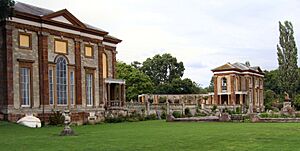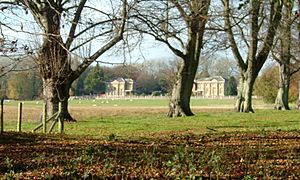Stoke Park Pavilions facts for kids
Imagine a grand old house that's mostly gone, but two amazing parts of it are still standing! These are the Stoke Park Pavilions. They are near a village called Stoke Bruerne in Northamptonshire, England. You can find them about 8 miles (13 km) south of Northampton and 11 miles (18 km) north of Milton Keynes.
Contents
What is Stoke Park?
Stoke Park is a very special place. It's listed as a Grade II historic park and garden. This means it's important for its history and design. The Pavilions are part of this park and are considered "outstanding" examples of old buildings.
The land around the Pavilions has old farm areas. You can still see signs of how fields were divided long ago. There are also four special farms built around 1840 by the 4th Duke of Grafton.
The Pavilions are like the two "wings" of a huge old house. The main part of the house is gone, but these wings remain. They are beautiful examples of the Palladian style, which was a popular way to design buildings.
The Park Today
Even though it was once one big estate, Stoke Park is now split up. It includes farmland and several private homes. Some of these homes are in converted farm buildings. The Pavilions themselves are also private homes.
It's not easy to visit the park. There's one public path that starts from Stoke Bruerne village. It crosses farmland and goes through part of the park. Another road, Stoke Park Lane, leads towards the Pavilions.
Sadly, some of the park's old charm has been lost. This is because of changes in farming and trees being cut down. However, some old tree-lined paths still exist.
There are also some modern farm buildings in the park. While they are useful for farming, they do change the historic look of the area. You might also hear some noise from activities like 'paintball' and clay pigeon shooting nearby.
The land around Stoke Bruerne and Stoke Park once belonged to the Longueville family. But they had to give it to King Henry VIII.
The Original Stoke Park House
Stoke Park was very important in English architecture. It was the first country house in England to use a special design called the Palladian plan. This plan involved a main house with two matching buildings (pavilions) connected by walkways.
This style was inspired by Andrea Palladio, an Italian architect from the 1500s. The Palladian style became very popular in England in the 1700s. But Stoke Park was built much earlier, around 80 years before! Many people believe Inigo Jones, a famous English architect, helped design it.
An old picture of the house from around 1700 can be found in a book called Vitruvius Britannicus. This book is about British architecture.
Sir Francis Crane and the House
King Charles I gave Stoke Park and its house to Sir Francis Crane. Sir Francis was a very important person. He started the Mortlake Tapestry Works in 1619. These works made beautiful tapestries (woven pictures) for royalty.
Sir Francis became rich from his work and from grants of land. He was given about 400 acres of Stoke Bruerne in 1629. He brought the design for the house from Italy. It's thought that Inigo Jones helped him build it.
The Pavilions Today
The two Pavilions you see today are what's left of the house built by Robert Crane in the late 1620s. They are the main feature of the park. There's also a lovely old garden from the 1600s with great views.
These Pavilions are some of the earliest Palladian buildings in England. Even though they've been changed a bit over time and one is now a home, they are still very important historically.
The main house was destroyed by a fire in the late 1800s. It was replaced by a new, large building. But that building was mostly taken down in the late 1940s after being used by the army during World War II.
The building that still stands today was once the service wing of that later house. It's now a private home. Around the Pavilions, there are other old farm buildings. These include a stable, a 1600s dovecot (for pigeons), barns, and old farmworkers' cottages. All of these are now homes. They show a mix of building styles from the 1600s, 1700s, and 1800s.
The west Pavilion used to hold the library. The east Pavilion was the chapel. In the gardens, you can find a statue of Sir George Cooke, who died in 1740.
Visiting the Pavilions
The Pavilions and the park are private property. They are only open to the public sometimes, usually in August afternoons, for a small fee. You might see signs near Shutlanger Road if they are open. They need to allow some public access to get funding to help preserve them.
You can also see the Pavilions from the A508 road between Northampton and Milton Keynes. They are about two miles south of Roade village. If you're driving south, there's a place to pull over (a lay-by) on the east side of the road. Be careful if you cross the road, as it's always busy!
You can also get a good view from a higher spot south of the site. Take the right turn to Alderton village from the A508, just before Grafton Regis.
Protecting the Area
The village of Stoke Bruerne and the area around Stoke Park are part of a big effort to protect their history. This is done by the South Northants Council. You can find more information, including maps and old documents, on their planning website.




